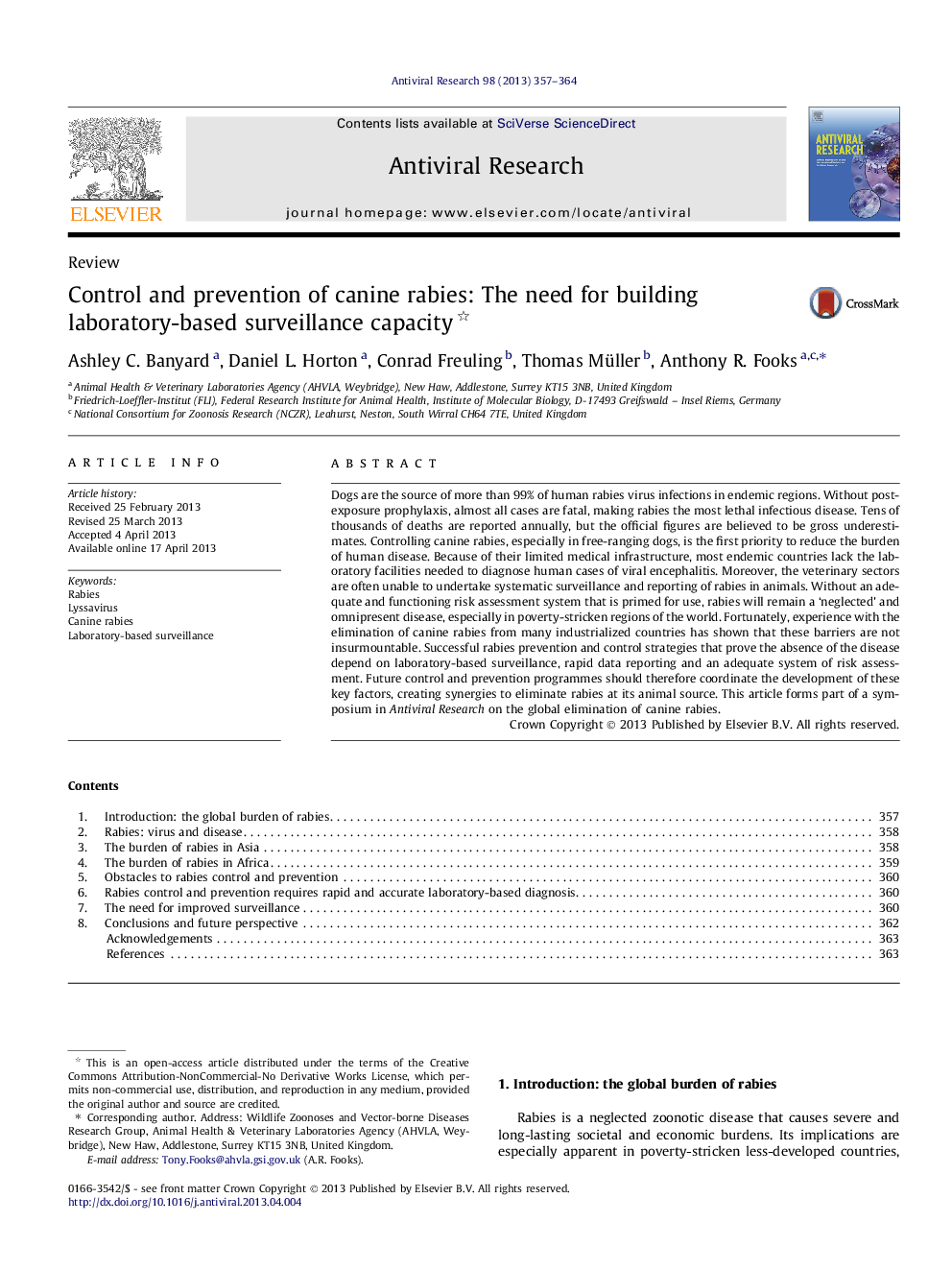| کد مقاله | کد نشریه | سال انتشار | مقاله انگلیسی | نسخه تمام متن |
|---|---|---|---|---|
| 5822374 | 1117940 | 2013 | 8 صفحه PDF | دانلود رایگان |
عنوان انگلیسی مقاله ISI
Control and prevention of canine rabies: The need for building laboratory-based surveillance capacity
ترجمه فارسی عنوان
کنترل و پیشگیری از هاریس های سگ: نیاز به ساخت ظرفیت نظارت مبتنی بر آزمایشگاه
دانلود مقاله + سفارش ترجمه
دانلود مقاله ISI انگلیسی
رایگان برای ایرانیان
ترجمه چکیده
سگ ها منبع بیش از 99 درصد از آلودگی های ویروس هاری را در مناطق اندمیک دارند. بدون پیشگیری از عوارض جانبی، تقریبا تمام موارد مرگ و میر هستند و هاری را کشنده ترین بیماری عفونی می کنند. ده ها هزار مرگ و میر سالانه گزارش می شوند، اما به نظر می رسد که آمار رسمی، کمبود های ناخوشایند است. کنترل زگیل های سگ، به ویژه در سگ های آزاد، اولویت اول برای کاهش بار بیماری های انسانی است. با توجه به زیرساخت های محدود پزشکی، اکثر کشورهای مبتلا به بیماری های آندومیک فاقد تجهیزات آزمایشگاهی مورد نیاز برای تشخیص موارد انسفالیت ویروسی هستند. علاوه بر این، بخش های دامپزشکی اغلب قادر به انجام نظارت و گزارش گیری سیستماتیک هاری در حیوانات نیستند. بدون یک سیستم ارزیابی ریسک کافی و کارکردی که برای استفاده آماده شده است، هاری ها به عنوان یک بیماری "غفلت" و همه جا حاضر به ویژه در مناطق فقیرنشین جهان باقی خواهد ماند. خوشبختانه، تجربه در مورد حذف هاریهای سگ از بسیاری از کشورهای صنعتی نشان داده است که این موانع غیرقابل تحمل نیست. استراتژی های پیشگیری و کنترل استقرار موفقیت آمیز که فقدان بیماری را اثبات می کنند بستگی به نظارت بر آزمایشگاه، گزارش سریع داده ها و سیستم مناسب ارزیابی ریسک دارد. بنابراین، برنامه های کنترل و پیشگیری آینده باید هماهنگ سازی توسعه این عوامل کلیدی، ایجاد همکاری برای از بین بردن جهش در منبع حیوانات آن است. این مقاله بخشی از یک سمپوزیوم در تحقیقات ضد ویروسی در مورد حذف جهانی رازیانه های سگ است.
موضوعات مرتبط
علوم زیستی و بیوفناوری
ایمنی شناسی و میکروب شناسی
ویروس شناسی
چکیده انگلیسی
Dogs are the source of more than 99% of human rabies virus infections in endemic regions. Without postexposure prophylaxis, almost all cases are fatal, making rabies the most lethal infectious disease. Tens of thousands of deaths are reported annually, but the official figures are believed to be gross underestimates. Controlling canine rabies, especially in free-ranging dogs, is the first priority to reduce the burden of human disease. Because of their limited medical infrastructure, most endemic countries lack the laboratory facilities needed to diagnose human cases of viral encephalitis. Moreover, the veterinary sectors are often unable to undertake systematic surveillance and reporting of rabies in animals. Without an adequate and functioning risk assessment system that is primed for use, rabies will remain a 'neglected' and omnipresent disease, especially in poverty-stricken regions of the world. Fortunately, experience with the elimination of canine rabies from many industrialized countries has shown that these barriers are not insurmountable. Successful rabies prevention and control strategies that prove the absence of the disease depend on laboratory-based surveillance, rapid data reporting and an adequate system of risk assessment. Future control and prevention programmes should therefore coordinate the development of these key factors, creating synergies to eliminate rabies at its animal source. This article forms part of a symposium in Antiviral Research on the global elimination of canine rabies.
ناشر
Database: Elsevier - ScienceDirect (ساینس دایرکت)
Journal: Antiviral Research - Volume 98, Issue 3, June 2013, Pages 357-364
Journal: Antiviral Research - Volume 98, Issue 3, June 2013, Pages 357-364
نویسندگان
Ashley C. Banyard, Daniel L. Horton, Conrad Freuling, Thomas Müller, Anthony R. Fooks,
